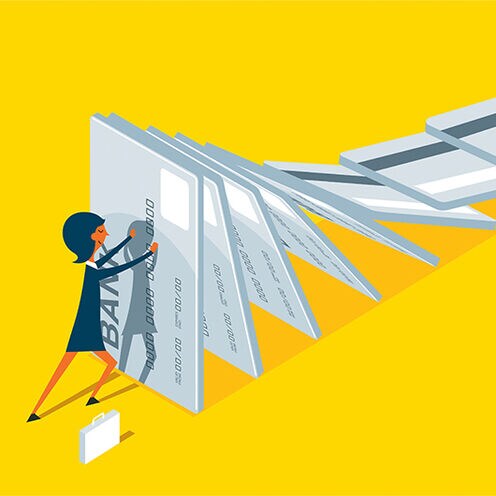
Gain Financial Freedom by Tackling Your Student Loan Debt
Find the help you need to navigate your student loan debt. Plus, learn how one alumna paid off $60,000 in student loans in five years.
I was the first in my family to go to college, and thankfully I graduated with just a little over $5,000 in student loan debt.
But then I decided to pursue a master’s degree, and now I am a proud graduate with many thousands of dollars of debt. With no one in my family who can give advice, I’ve had many questions about how to manage my monthly student loan payments within my budget
Of course, I have lots of company. Some 44 million Americans collectively owe $1.5 trillion on their student loans, according to the National Student Loan Data System. The Institute for College Access and Success estimates that bachelor’s degree holders from the class of 2016 are carrying an average debt ranging from a low of $20,000 (in Utah) to a high of $36,350 (in New Hampshire).
How can you get educated on minimizing and managing your debt? Right now, even though both public and private student loan programs are a morass of information and qualifications, it's important to understand your loans at the source. There's no substitute for reading the fine print before you make any adjustments to your current payment plans.
But you don’t have to pay a financial advisor to help you, suggests Drew M. Anderson, an economist who studies the economics of student financial aid for the RAND Corporation. “Financial advice can be very valuable,” Anderson says, “but when it comes to student loan repayment plans, there’s free advice out there.” He suggests that if you have federal loans, you’ll want to spend some time on the Office of Federal Student Aid website researching all available payment plans. You can also call to get advice on the best repayment plan for you. And if you took out private loans, Anderson suggests, call and “talk to your loan servicer” to consider whether you’re getting the best deal on payment plans.
Here are tips to get you started.
Know What You Owe
Do you owe payments on a federal loan, a private loan, or both? If you’re unsure, log in to the National Student Loan Data System and see all of your federal loans in one place. “It’s a federally run website, so it’s not only accurate, but it will help you understand what loans are federal,” says Joe Holberg (Chi-NWI ‘11), who founded the financial health and wellness technology platform, Holberg Financial. “If you’re sitting there and you’re like, ‘I owe $30,000 and only $20,000 shows up on this NSLDS site,’ then $10,000 are private loans.”
Private loans could cost more in interest rates than federal loans (the federal government sets student loan interest rates once a year), and they lack the repayment benefits federal loans provide. If you’re paying high interest on private loans, you could look into refinancing, perhaps through a credit union that could offer a lower interest rate. You’ll almost certainly want to shop around and read the fine print on any payment plan.
Finally, you can consider refinancing all your loans—federal and private—into one private re- payment plan, but Holberg advises caution. “If you are not in education, and you are not planning to return to education, and you have a very high degree of certainty around your ability to repay your loans, that’s the only use case where ditching federal loans and refinancing with private loans makes sense.”
Take Advantage of the Benefits of Your Federal Loans
There are many types of federal student loans, each with different benefits, each carrying multiple caveats.
You may be able to join an income-driven payment plan that caps the size of your monthly payment based on how much you earn. Holberg suggests that in almost every case, it makes sense for educators to take advantage of such a plan to stay within their budgets. “You’re literally making it easier to stay in education for longer” when teachers “fill out a one-page piece of paper,” he says.
You may also be able to defer your federal loans while you’re teaching, which is what Sashai Jasper (N.Y. ’06) did. As director of teacher support at the nonprofit OneGoal, Jasper now counsels high school students on comparing the costs and benefits of loans and financial aid plans before choosing a college. Jasper had to take out emergency private loans in her sophomore year of college, and she wasn’t able to defer those payments while she was teaching.
If you work for the government or a nonprofit organization, you may qualify for the Public Service Loan Forgiveness (PSLF) Program, which forgives the remaining balance of your loan debt after you’ve made 120 qualifying monthly payments (note that requirements are exacting and can be confusing). The federal government also offers a Teacher Loan Forgiveness Program, which forgives between $5,000 and $17,500 in student loan debt for educators who have taught for five years and meet qualifying criteria. (The amount forgiven varies depending on the subject you teach.)
But there can be a caveat for those who are trying to ‘double-dip’ in both student loan forgiveness programs. “If you get teacher loan forgiveness after five years, the time that counted towards the teacher loan forgiveness program cannot be double-counted for public service loan forgiveness,” Holberg cautions.
If you borrowed under a federal Perkins Loan and taught in a qualifying school system, you may be eligible for the Perkins Loan Teacher Cancellation program, even if you tapped one of those other loan forgiveness plans.
AmeriCorps benefits can also offer significant relief. Teach For America corps members who enroll in AmeriCorps may be eligible to post- pone payments on their qualified student loans, and the government will pay up to 100 percent of the interest that accrues on those loans after each successful year as an AmeriCorps member. During those two years, many corps members earn more than $11,000 in AmeriCorps’ Segal Education Awards, taxable income that can be used to pay off qualified student loans, now or in the future.
Resource: The Institute for College Access and Success publishes online a list of The Top 10 Student Loan Tips for Recent Graduates
This article is provided for general information only. Nothing contained in the material represents a recommendation for management of any public or private loans.
How I Paid Off $60,000 in Student Loans
Syedah Asghar (San Antonio ’14), left college owing $60,000 on her student loans. She spent four years teaching before moving into her current job as a manager of teacher leadership development in Teach For America’s San Antonio region.
Asghar did not qualify for any federal student loan forgiveness programs, so how did she pay off her full debt in five years? Planning, work, and sacrifice.
First, she took advantage of her AmeriCorps benefits. For each year she taught while in the corps, she received a $5,000 benefit which she applied to paying off loans.
Then she devised a strategy. Asghar owed her first student loan payment in August 2014. She created a spreadsheet that listed all her loans and their interest rates. She paid off the loans with the highest interest rates. Even though she owed a monthly payment of $280, she budgeted and paid off $500 per month in her first two years of repayments, about $1,000 a month in year three, and $1,500 a month in year four. Whenever she had additional money to spare, she used it to pay off more debt.
And she economized. Asghar skipped a gym membership and cable. She held on to her iPhone 4 for four years. She tutored during the school year, and managed and taught summer school. There were things she coveted. “If I didn’t need them, I didn’t buy them,” Asghar says.
Asghar made her final student loan payment in July of this year. And what’s in her pocket now? An iPhone 5.
Sign up to receive articles like this in your inbox!
Thanks for signing up!
Content is loading...


